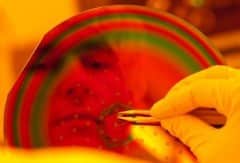Moving towards creating a quantum computer: researchers have created a topological quantum insulator that can overcome one of the biggest problems on the way to creating stable qubits

Researchers from Rice University have created an "electronic fast lane", which could contribute to the construction of a quantum computer. In their paper, which was published in Physical Review Letters, they describe how they created a "quantum topological insulator". The device is a significant step on the way to creating quantum particles that store and process information.
Normal computers use binary bits. Each character on a computer is represented by a long string of 0's and 1's. Each bit can be in state 0 or state 1, but cannot be both. On the other hand, a quantum bit (qubit) is in both states - this is possible due to the peculiarities of the world of quantum particles.
This duality significantly increases the number of representation and computational possibilities of a quantum computer. "In principle, we do not need a large number of qubits in order to create a powerful computer," says Professor Roy-Roy Du, one of the team of researchers. For the sake of demonstration, "a normal microprocessor with 1 billion transistors is roughly equal to a quantum processor with only 30 qubits". This gives quantum computers a huge advantage over ordinary computers, in areas such as coding and encryption, climate modeling and biological simulations.
In their long-running attempts to create a quantum computer, scientists around the world have tried to come up with various methods to create stable qubits. One of the most difficult problems facing them is how to create a qubit whose information is not affected or destroyed by quantum fluctuations (fluctuations). The meaning of quantum fluctuations is particles and anti-particles that are created and after a short time disappear - they are called virtual particles, and it is easy to understand why they may damage the operation process of the quantum computer.
In order to deal with the problem, the scientists conceived the idea of "topological quantum computing". The solution is to ensure that each qubit is composed of a pair of fixed quanta that share the same virtual identity. But there is a problem - particles of this type, which are called "Majorana fermions" have never been created or observed - today they are completely theoretical.
Antiparticles have the same properties as particles, except for one thing - they have an opposite electrical charge. Whereas Miorana fermions are a type of particles which are exactly the same as their antiparticles (because they have a neutral charge).
Although the idea was introduced as early as 1937, only now is the race to create Fermion Miorana pairs in chips. The Rice University scientists believe they can be created by attaching a two-dimensional insulator to a superconductor. That's exactly what the researchers did.
Although electricity cannot flow through a topological insulator, it can flow around its outer edges. If a small topological insulator is connected to a superconductor, the device can theoretically create qubits, explains Ivan Kenz, one of the research team.
According to the scientists, "We are very optimistic about the next step. Now, only experiments will be able to verify whether we have found the Miorana fermions, and whether they are indeed good candidates on the way to creating stable qubits."
Yaron Fruchtman participated in the preparation of the news.

2 תגובות
Stunning
Wow